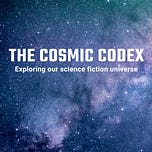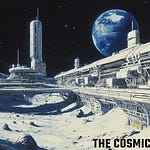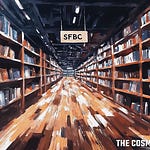by Brian Scott Pauls, written using ChatGPT
This past December, the National Ignition Facility in California produced a fusion reaction which generated more power than that required to start the process—a first-of-its kind achievement.
I’ve heard commercially viable fusion power is just “twenty years away” for the past forty years. Is it finally true this time? Or will we still be saying the same thing in another forty years?
Imagine an energy source that can generate power with minimal pollution and with fuel so abundant it could last for millions of years. This is the lure of nuclear fusion, the process of merging atomic nuclei to release energy. It’s the reaction driving the lifecycle of the stars, including our Sun.
Fusion is a fascinating concept that has captured the imaginations of some of science fiction’s most well-known authors. For example:
The Moon is a Harsh Mistress (1966) by Robert A. Heinlein
Set in the year 2075, this influential sf novel tells the story of a lunar colony's revolt against Earth's oppressive rule. The colony harnesses energy using both solar power and a type of fusion generator described as a “magnetic pinchbottle”, fueled by water from lunar ice.
Nuclear fusion ends up powering the decisive weapon in the political struggle between Earth and the Moon.
”The Warriors” (1966) by Larry Niven
A short story originally published in Worlds of If magazine in 1966 and later collected in The Tales of Known Space in 1975, “The Warriors” not only introduces the fierce Kzinti species, it also teaches one of Niven’s key lessons:
“A reaction drive's efficiency as a weapon is in direct proportion to its efficiency as a drive."
The “weapon” at issue in this story is “…a light-pressure drive powered by incomplete hydrogen fusion”—a Bussard ramjet.
Midas World (1983) by Frederik Pohl
This “novel” is really a collection of short stories, originally published between 1956 and 1983, about the consequences of low-cost energy from nuclear fusion. Pohl readily acknowledges and explores the potential downsides (including global warming—because even fusion produces waste heat) of what we often see as a utopian idea.
The Quest for Fusion Power
The potential for clean, abundant, and efficient energy has driven decades of research, experimentation, and development. For nearly a century, the potential of harnessing fusion power for human use has intrigued scientists and engineers.
Let’s look at fusion’s history:
Early Fusion Research (1920s-1950s)
The concept of fusion power emerged in the 1920s, when scientists discovered that stars, including our Sun, produce energy through nuclear fusion. In this process, light atomic nuclei, usually hydrogen isotopes, combine to form heavier nuclei, releasing energy. Researchers quickly recognized the potential for generating useable power.
The Tokamak and Stellarator: Pioneers of Magnetic Confinement Fusion (1950s-Present)
In the 1950s, fusion research shifted toward developing practical applications. Early efforts focused on creating the conditions necessary for fusion, including extremely high temperatures and pressures. Two primary approaches emerged during this time: inertial confinement fusion (ICF) and magnetic confinement fusion (MCF).
Inertial confinement fusion involves compressing a small fuel pellet to high densities and temperatures using an external force, such as a laser.
Magnetic confinement fusion uses magnetic fields to contain and control plasma, the ionized gas that forms when atoms are heated to extreme temperatures.
The first significant breakthrough in fusion power came in the form of magnetic confinement devices. Soviets Andrei Sakharov and Igor Tamm conceived of the “tokamak”, a toroidal (doughnut-shaped) magnetic confinement device in 1950.
Lyman Spitzer, an American astrophysicist, proposed the “stellarator” in 1951. It used a twisted magnetic field to confine plasma, but early stellarator designs encountered difficulties in keeping the confinement stable.
The tokamak design was more successful. In 1968, the Soviet Union's T-3 tokamak achieved a significant milestone: temperatures over 10 million degrees Celsius. This advancement sparked optimism in the scientific community and prompted increased funding for fusion research. By the 1970s, the tokamak became the most widely used design for magnetic confinement fusion research.
In 1978, the United States, the Soviet Union, Japan, and Europe agreed to collaborate on what eventually became the International Thermonuclear Experimental Reactor (ITER) project. This ambitious endeavor aimed to design, construct, and operate a large-scale experimental tokamak to show the feasibility of fusion as a viable energy source.
ITER has faced many challenges, including budget overruns, delays, and technical issues. Despite these setbacks, progress continues, with major milestones, including the completion of the reactor's base in 2019 and the start of assembly in 2020.
Commonwealth Fusion Systems, in collaboration with the Massachusetts Institute of Technology, is developing the SPARC project, which aims to show net energy gain from a compact tokamak design by the mid-2020s. If successful, this could pave the way for the construction of ARC, a proposed pilot power plant that could be operational in the 2030s.
Alternative Approaches (1960s-Present)
While the tokamak has dominated research, other approaches have emerged and gained traction.
Alternative fusion concepts are distinct from the mainstream approaches of MCF and ICF. They explore innovative techniques, fuels, or reactor designs to achieve fusion, often with the goal of simplifying the process or reducing the engineering challenges associated with traditional approaches. Field-reversed configuration (FRC), and magneto-inertial fusion (MIF) are two of the most promising methods.
Research into FRC began in the 1960s. Within such a configuration, “…the plasma has the form of a self-stable torus.” This could allow for fusion reactors with “simpler, easier construction and maintenance.”
Tri Alpha Energy, now known as TAE Technologies, is a private fusion research company founded in 1998 that focuses on the development of FRC.
TAE Technologies has made significant progress in FRC research over the years, developing advanced reactor designs and showing the stability of FRC plasmas. In 2015, the company announced that its experimental FRC device, C-2U, had successfully created configurations “…lasting 5 milliseconds, a more than 10-fold improvement in lifetime.” TAE Technologies continues to refine its FRC approach, with the goal of achieving a net energy gain and ultimately commercializing fusion power.
Magneto-inertial fusion “…combine[s] aspects of magnetic confinement fusion and inertial confinement fusion in an attempt to lower the cost of fusion devices. MIF uses magnetic fields to confine an initial warm, low-density plasma, then compresses that plasma to fusion conditions…”
A notable fusion start-up, Helion Energy, was founded in 2013 with the goal of developing a commercially viable fusion reactor based on MIF. Their design uses a pulsed magnetic field to compress and heat a mixture of deuterium and helium-3, creating a fusion reaction. The company has made steady progress in the development of its MIF technology, and its goal is to show net energy gain within the next few years, paving the way for a practical, modular fusion power plant.
Breakthrough (2022-Present)
In late 2022, the National Ignition Facility (NIF), at Lawrence Livermore National Laboratory in California, announced a fusion breakthrough. The NIF focuses primarily on inertial confinement fusion.
On December 5, the facility's experiments achieved a critical milestone known as "ignition," where the energy released by fusion reactions exceeded the energy input required to start the reaction.
To be clear, the lasers which initiated the reaction delivered 2.05 megajoules (MJ) of energy to the target. The reaction then produced 3.15 MJ of energy—a net gain. The lasers, however, “draw about 300 MJ” of energy to deliver the 2.05 MJ required to start the process. We’ve still got a long way to go before we get to a practical fusion generator.
Nevertheless, this marks a significant step forward in the global effort to develop practical fusion power. NIF has showed the feasibility of harnessing fusion reactions for energy production, boosting optimism and momentum within the fusion research community.
This milestone is expected to have far-reaching implications for both ICF and the broader fusion landscape. Researchers will continue to analyze the data generated by the successful ignition experiment, refining their models and experimental designs to further optimize the fusion process.
The NIF breakthrough is likely to encourage increased investment in fusion research, providing much-needed resources to help advance the development of fusion energy technologies. As fusion research gains momentum, we can expect to see further breakthroughs and innovations that bring us closer to realizing the dream of a clean, abundant, and efficient energy source.
Issues to Explore
While viable fusion power remains speculative technology, the ongoing progress continues to provide excellent material for sf scenarios:
The Fusion Arms Race
In 2045, the race to develop commercially practical fusion has intensified. Major world powers are locked in a fierce competition to harness fusion energy, not only for its potential to solve the world's energy needs but also for possible military applications.
As these nations race to develop fusion-powered weaponry, the world becomes more and more unstable. Espionage, sabotage, and scientific intrigue are rampant, with governments vying for any advantage they can gain in the fusion arms race. Amidst the chaos, a cabal of scientists from various nations, disillusioned by the weaponization of their life's work, secretly collaborate on a project to make fusion available to anyone, for any purpose. Rich countries and their militaries will no longer be able to monopolize this transformative technology.
The team faces incredible odds, evading capture by their governments and navigating a web of political intrigue. Can they succeed, or will fusion benefit the few, at the expense of the many?
Fusion Power Saves Earth from an Energy Crisis
The year is 2075, and Earth is facing looming energy shortages because of the depletion of fossil fuels and a growing population. Climate change has reached a tipping point. Without an alternative energy source, civilization is on the brink of collapse.
Just when all hope seems lost, a brilliant team of researchers makes a groundbreaking discovery in fusion power research. They develop a reactor using seawater as fuel. This achievement ushers in a new era of sustainable energy production, averting the energy crisis. But can the world use this new technology to mitigate the effects of climate change, or will it make the problem worse? How will humanity deal with fusion’s waste heat, a complication Pohl foresaw in Midas World?
The Fusion-Powered Space Odyssey
By 2150, recent advancements in fusion power research have revolutionized space travel. Humanity has harnessed the power of compact fusion reactors to drive their spacecraft, enabling interplanetary travel at unprecedented speeds. As a result, scientists and adventurers can journey to the far the limits of our solar system, exploring the planets, moons, and asteroids while searching for signs of extraterrestrial life.
The United Nations organizes a mission to the Jupiter system. Aboard a fusion-powered spacecraft, the crew embarks on a multi-year mission to establish a new colony and unravel the mysteries of these many worlds.
While approaching the asteroid belt between Mars and Jupiter, several crew members mutiny. They seize the ship and claim the wealth of the asteroids for their secretly allied countries.
How will Earth respond? Can humanity finally work together for the common good, or must we take war with us to the planets?
Twenty years away?
Projections for commercially viable fusion power in the next two decades remain uncertain but optimistic. The successful development of fusion depends on continued progress in research, technological advancements, and sufficient investment in the field. Several major projects and private ventures are aiming to make strides in fusion technology over the coming decades.
ITER’s first plasma test is expected in 2025, and deuterium-tritium fusion experiments are planned for 2035. ITER, however, is an experimental reactor not intended for commercial electricity production.
In parallel with ITER, several private ventures and start-ups are working on their own fusion technologies, with some aiming to achieve commercial viability within the next twenty years. Companies like Commonwealth Fusion Systems, TAE Technologies, and Helion Energy have the potential to speed up the timeline for practical fusion power.
While it’s challenging to predict an exact timeline for commercially viable fusion, the next twenty years are expected to see significant advancements in fusion research and technology. These developments have the potential to bring commercial fusion closer to reality, although it remains to be seen if they can be realized within the estimated timeframe. As research continues, the outlook for fusion power may become clearer and more certain.















Share this post